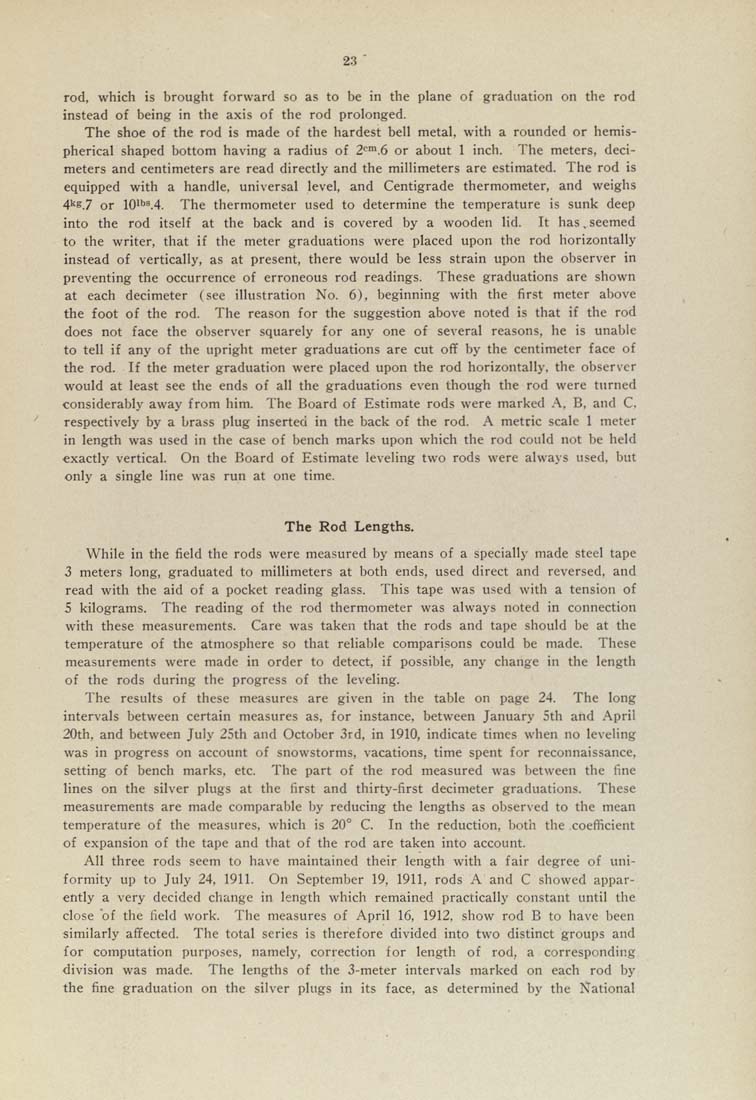rod, which is brought forward so as to be in the plane of graduation on the rod
instead of being in the axis of the rod prolonged.
The shoe of the rod is made of the hardest bell metal, with a rounded or hemis¬
pherical shaped bottom having a radius of 2'"^.6 or about 1 inch. The meters, deci¬
meters and centimeters are read directly and the millimeters are estimated. The rod is
equipped with a handle, universal level, and Centigrade thermometer, and weighs
4''s.7 or 10"'=.4. The thermometer used to determine the temperature is sunk deep
into the rod itself at the back and is covered by a wooden Hd. It has,seemed
to the writer, that if the meter graduations were placed upon the rod horizontally
instead of vertically, as at present, there would be less strain upon the observer in
preventing the occurrence of erroneous rod readings. These graduations are shown
at each decimeter (see illustration No. 6), beginning with the first meter above
the foot of the rod. The reason for the suggestion above noted is that if the rod
does not face the observer squarely for any one of several reasons, he is unable
to tell if any of the upright meter graduations are cut off by the centimeter face of
the rod. If the meter graduation were placed upon the rod horizontally, the observer
would at least see the ends of all the graduations even though the rod were turned
considerably away from him. The Board of Estimate rods were marked A, B, and C,
respectively by a brass plug inserted in the back of the rod, A metric scale 1 meter
in length was used in the case of bench marks upon which the rod could not be held
exactly vertical. On the Board of Estimate leveling two rods were always used, but
only a single line was run at one time.
The Rod Lengths.
While in the field the rods were measured by means of a specially made steel tape
3 meters long, graduated to millimeters at both ends, used direct and reversed, and
read with the aid of a pocket reading glass. This tape was used with a tension of
5 kilograms. The reading of the rod thermometer was always noted in connection
with these measurements. Care was taken that the rods and tape should be at the
temperature of the atmosphere so that reliable comparisons could be made. These
measurements were made in order to detect, if possible, any change in the length
of the rods during the progress of the leveling.
The results of these measures are given in the table on page 24. The long
intervals between certain measures as, for instance, between January 5tb and April
20tb, and between July 25th and October 3rd, in 1910, indicate times when no leveling
was in progress on account of snowstorms, vacations, time spent for reconnaissance,
setting of bench marks, etc. The part of the rod measured was between the fine
lines on the silver plugs at the first and thirty-first decimeter graduations. These
measurements are made comparable by reducing the lengths as observed to the mean
temperature of the measures, which is 20° C. In the reduction, both the coefficient
of expansion of the tape and that of the rod are taken into account.
All three rods seem to have maintained their length with a fair degree of uni¬
formity up to July 24, 1911. On September 19, 1911, rods A and C showed appar¬
ently a very decided change in length which remained practically constant until the
close "of the field work. The measures of April 16, 1912, show rod B to have been
similarly affected. The total series is therefore divided into two distinct groups and
for computation purposes, namely, correction for length of rod, a corresponding
division was made. The lengths of the 3-meter intervals marked on each rod by
the fine graduation on the silver plugs in its face, as determined by the National
|








